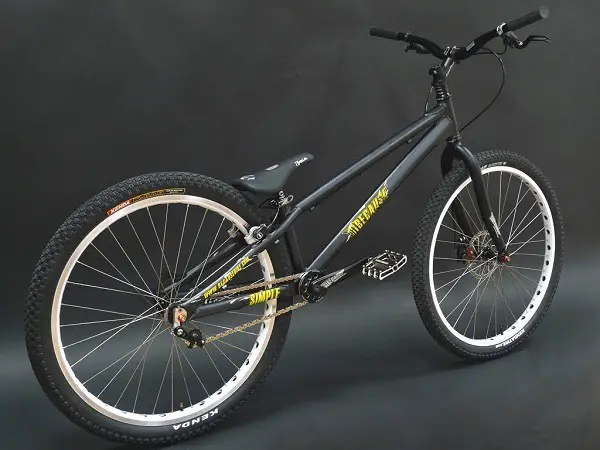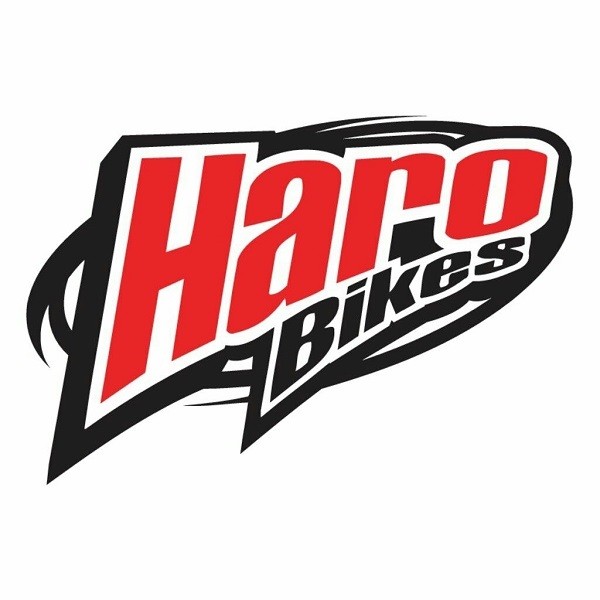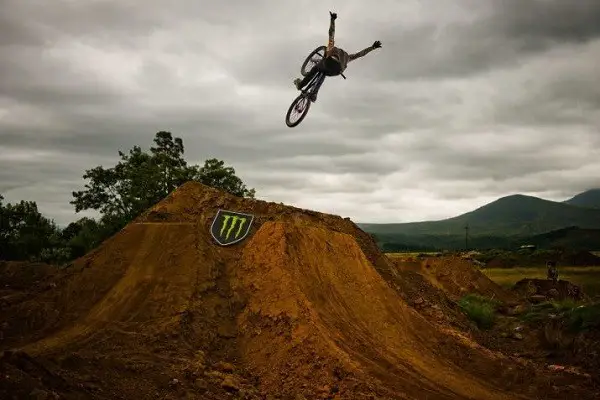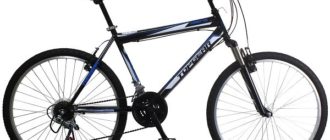Since its invention, the bicycle has come a long way from an ordinary “bone shaker” to a real miracle of engineering. For a long time, the design of the bike remained primitive and uncomplicated, and its main purpose was to move exclusively on flat roads.
The emergence of mountain biking in 1970 was the impetus for a bicycle revolution. Bicycle enthusiasts began to explore the rugged terrain. It turned out that a bicycle could ride smoothly over steep slopes, loose sand and mud. Thus, new disciplines emerged in the world of cycling. Dert-jumping and street-rials are becoming more and more popular every day. And today we are going to talk about the bikes that are blurring the boundaries and opening up new horizons. The dart bike and street bike are the protagonists of this article.
What are a dart and straight
In literal translation from the English word dirt-jumping means “jumping on dirt”. Not the most aesthetically pleasing name for a sport discipline, but there is something special about it. Otherwise, dirt-jumping would not be a separate sport. By dirt-jumping we mean riding a bike on a special track with ramps. Ups and downs, dizzying jumps and stunning pirouettes in the air – the spectacle is an indelible impression.
Unlike dirt-jumping, street-jumping is a cycling discipline that stays within the city limits. It is the same cycling on a special track, but all the obstacles are assembled from the urban landscape. Here, too, there are dizzying jumps and overcoming obstacles, but it all takes place on concrete terrain.
Uninitiated person may think that dirt-jumping and street-rial – are identical concepts. The only difference is in the track. Accordingly, on the same bike you can engage in two types of cycling at once. But this is not the case. There are quite a few subtleties and nuances that can not be ignored.
Characteristics of bicycles for street and dert
Enduring, reliable and resistant to mechanical damage bikes for street and dert belong to the same category of modified mountain bikes. But you can not call them the same – between them there are obvious differences, which are due, above all, the specifics of the track and features of operation. And here we should pay attention to the name of the discipline:
- dirt-jumping from the word “dirt, dirty”.
- Street-jumping from the word “street”.
The latter discipline involves performing difficult tricks with the transfer of the center of gravity on the back wheel. The variety of elements in this sport implies certain technical characteristics of bicycles and their perfect controllability.
In fact, all varieties of bikes for dirt-jumping and street-rial are modifications of mountain bikes or BMX-bikes. As a rule, it is quite heavyweight models on wheels no larger than 26 inches in diameter. A distinctive feature – the transmission with one speed. The fact is that the presence of several gears gives absolutely no advantage. Rather the contrary – increase already considerable weight of a bike.
Beginners fans of extreme sports can buy special bikes of mass production. They are called “komplits”, and they are designed for minor loads. More experienced and professional athletes assemble their horse on their own, carefully selecting components taking into account the style of riding and the peculiarities of the track.
Features
So what is the difference between bikes for dirt-jumping and street-rials and good mountain bikes? Let’s take a closer look at the features of design:
- Frame. The basis of a bicycle must withstand extremely high loads. It should be taken into account that during the performance of tricks rider performs jumps from a fairly high altitude. Not every aluminum tube is able to withstand powerful shocks and other mechanical effects. Chromol (steel-based alloy, alloyed with chrome and molybdenum) is just the thing: the material softens loads and effectively absorbs shocks. Professional athletes often choose frames with variable wall thickness, where a thicker layer is located in the most vulnerable places. There are also decent variants of frames made of aluminum alloy. They are not as strong as chromium or carbon, for example, but quite suitable for beginner riders who are just learning the essence of extreme types of cycling. Series “kits” are often built on Hi-Ten steel frames.
- Frame geometry. And here is where the clear difference between classic mountain bikes and their modifications for extreme sports begins to show. Moreover, experienced athletes clearly see the difference in the geometry of the bike for street and dert. The main difference is the length of the upper tube. For dert it is 570-590 mm, the rear triangle is limited to a limit of 410 mm, and the angle of the steering column is 68-70 degrees. In turn, bikes for street-rial have a much larger angle of inclination of the steering column (71-74 degrees), and the length of the frame does not exceed 545 mm.
- Position of the carriage. Bicycles for dirt-jumping have a carriage located at the same height as the hub, and sometimes slightly below it. This allows to lower the center of gravity, provide better acceleration and predictable behavior of the bike in flight. As for street-racing models, the carriage is slightly higher, allowing you to lift the frame vertically with less effort. Moreover, with a moderately high position of the carriage is much easier to mount pipes-pegs, which are needed to overcome railings and other similar obstacles.
- Wheel Diameter. The universal size for both disciplines is 24 inches. But even here it is not without significant differences. For example, for the assembly of dart bikes the following scheme is used: the diameter of the front is 26 inches, and 24-inch wheel is put in the back. In the straight, the size of the wheels are identical – as a rule, it is 24 inches. This allows for good bike handling and high maneuverability, which are key concepts for this discipline.
- Type of fork. In bikes of this plan there are only two types of forks: rigid (rigid) or shock-absorbed with a short stroke of no more than 130 mm. For street bikes the first option is optimal: it gives a full control over the bike’s behavior and the greatest possible range of travel. The scope of shock-absorbed forks is bikes for dirt-jumping. But here we have to mention a nuance: they are put in the most budget version on series “komplits”, and because of that they quickly fall into disrepair.
- Rudder. The width is the main parameter in this component. It depends on the rider’s dimensions. In particular, for male athletes the optimum width of the handlebar is 700 mm, for women and teenagers – 680 mm. It also matters and the type of fork: for the rigid type, the height of the handlebar should be at least 3 inches, for shock-absorbed – at least 2 inches. On bikes for street-rials are sometimes put handlebars with a short stem (from 36 to 50 mm).
- Brakes. Someone will say that on bikes of this plan they are not needed. Partly, some of this is true – experienced athletes, confident in their abilities and the capabilities of the bike, you really do not need a brake (it only increases the weight of the bike). But beginner riders who hone their skills on “komplits” need brakes for sure. Disc brakes provide sufficient safety. Mechanics or hydraulics? Here everyone is entitled to decide for himself what is more convenient and practical to use. But let’s say that the mechanics is easier to service, while the hydraulic brakes are more convenient to use.
As you can see, there are differences and there are quite a few. It is the totality of these points has a direct impact on the success of performing tricks and the safety of the cyclist. Let us note another feature concerning the saddle of the bicycle. Both on BMX-models, and on bicycles for dirt-jumping and street-rials put light and compact saddles ergonomically shaped.
List of manufacturers
The bicycle industry is a huge number of manufacturers. Some of them have long made a name for themselves and now just maintain a good reputation, producing reliable and high-quality bicycles – Santa Cruz, for example. Someone just recently entered the market and is now trying by all means to draw the attention of consumers, producing a wide variety of models, trying to cover the widest range of customers.
Manufacturers of bicycles for street and derby are a separate category of brands known only to a narrow circle of athletes and fans of extreme riding. As a rule, these are quite mature companies that produce high-performance bicycles of the highest quality. Let’s outline a few of the most famous names.
HARO .
An American company that produces bikes for different types of freestyle, as well as a variety of components and accessories of such plan. The company was founded back in 1978. Its founders decided to focus on the production of highly specialized bikes, designed for extreme riding. Today, their products are the subject of attention of professional riders. The brand has a line of BMX bikes and mountain bikes. Haro was the first company to establish the production of freestyle frames and forks, and its bikes are considered the best units for street and dert.
Specialized
The name of this brand is on everyone’s ears who has at least once been interested in the variety of bicycles designed for extreme riding. Specialized is an American company that specializes in the production of profile bikes for street, dert and other challenging disciplines. The brand has earned the honorary title of chief innovator – Specialized regularly introduces brand new solutions to the market, thus staying ahead of the competition, and sometimes ahead of time. The company’s history began in 1974. During this time the brand has come a long way from the creation of custom models based on individual projects to mass production of mass-produced bicycles in various classes and categories. Bicycles Specialized are not cheap, but for the money the buyer receives unsurpassed quality, warranty and durability.
The company Specialized is the leading manufacturer of bikes for dirt-jumping and street-rials. Professional athletes on bikes with the famous logo are often winners of international competitions in their respective disciplines. The P-series 3 features a premium aluminum frame, forged dropouts and a 100mm sport fork.
NS Bikes
Another manufacturer, but already of Polish origin. The company specializes in the production of bicycles for freestyle and other extreme disciplines. The brand competes quite successfully with the mastodons of the cycling market (including American manufacturers). NS Bikes has mastered the production of frames for street bikes since 2000. In addition, this same company produces a fairly large variety of components and parts for custom bikes.
Among the variety of models, it is worth highlighting a separate line for dirt-jumping and street-rials. We are talking about Slash Junior. In this category Metropolis, Clash 2, Moverment are very promising models. Attention should also be paid to bikes that have recently been introduced to a wider audience – it is Fuzz and Snabb.
Recommendations for choice
So, you are going to master the extreme technique of skiing and even managed to achieve some results. What kind of bike will fully meet the needs of the rider? Bike for street or dert should be enduring, controllable, responsive and have impeccable technical characteristics. But other parameters should be taken into account:
- The height of the cyclist. This is one of the main criteria on which to choose a bike. Frame size is crucial. Cyclists with height above 180 cm should consider bikes with wheels at least 26 inches.
- Type of rubber. Here it is necessary to take into account the specifics of this or that discipline. It is clear that in dirt-jumping wheels will ride on loose soil, and in straight – on smooth asphalt. But in both cases, the rubber should be of high quality, and the wheels exclusively with double rims. Experienced riders recommend using tires with a pronounced tread pattern or regular slicks for durt. For extreme riding in the stone jungle, regular slicks are also suitable.
- Transmission and number of gears. For some reason manufacturers still prefer to offer the consumer a series model of bicycles for dirt-jumping and street-rials, equipped with a multi-speed transmission. As practice shows, this option often becomes superfluous, weighing down the bike. But that is not all. Worsening the situation is the fact that the presence of a multispeed transmission takes strength away from the frame and other components. It is done more often for the purpose of economy. True, it is not clear, in what exactly this economy is manifested. Therefore, we recommend looking for a bike without unnecessary components.
- Material of frame and fork. As you have probably already become clear, the occupation of a street-jumping and street-rials – not a cheap pleasure. The manufacturer should produce a bike as reliable as a Kalashnikov assault rifle, which will not allow the rider to get hurt. Accordingly, the material of frame and fork is obviously not aluminum. And if it is, then the highest quality alloy, providing high strength and resistance to mechanical stress. Optimal variant – chromium.
If you are just starting out in the extreme disciplines of cycling, pay attention to the ready-made variants of assembling bicycles. Among the completers there are many decent models that will allow you to learn basic tricks and will last for several seasons.
Operating tips
Surely you have already realized that today’s conversation was about quite dangerous disciplines of cycling. Dirt-jumping and street cycling – it is extreme and a certain risk, it is a serious physical training and, of course, injuries. Even experienced athletes are not immune to falls. Therefore, buying a bike for street or derby, you should buy the appropriate protection for the head and limbs.
When breaking the bike is not recommended to independently replace some parts with cheaper components. Keep in mind that a jump even from a small height and the subsequent landing on a hard surface is a process in which absolutely all the parts and components of the bike experience a tremendous and intense load. A cheap part of dubious quality simply cannot withstand this, and the consequences can be most unfortunate.
Before you go out on the track, the cyclist should check the technical condition of his bike, the quality of attachment and the serviceability of all components. Here you need to understand that the condition of the bike depends on the safety of riding. Of course, regular maintenance of the bike should become a kind of ritual.
We should say a few words about bikes for dirt-jumping. They are literally “bathed” in dirt, so cleaning and lubrication of all nodes are mandatory procedures after every ride.
Conclusion
To summarize, we can say that dirt-jumping and street-rials – a separate category of extreme disciplines, associated with certain risks and injuries. That is why specific varieties of bicycles that can withstand dynamic loads and difficult operating conditions appeared.










